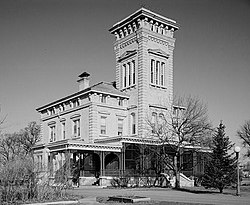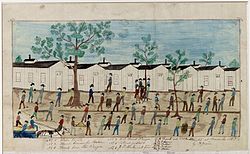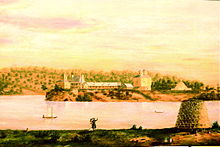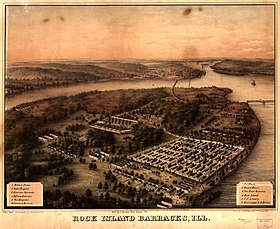
Back Rock Island Arsenal German Rock Island Arsenal French Rock Island Arsenal Portuguese Рок-Айлендский арсенал Russian Rock Island Arsenal Swedish Рок-Айлендський арсенал Ukrainian
| Rock Island Arsenal | |
|---|---|
| Rock Island Arsenal, Rock Island Township / Moline Township, Rock Island County, Illinois | |
| Type | Army post |
| Site information | |
| Controlled by | U.S. Army |
| Website | Official Website |
| Site history | |
| Built | 1862 |
| In use | 1862–present |
| Garrison information | |
| Garrison | Joint Munitions Command Joint Manufacturing and Technology Center U.S. Army Corps of Engineers, Rock Island District United States Army Sustainment Command First United States Army |
Rock Island Arsenal | |
 Rock Island Arsenal, Quarters 1 (Building 301) | |
| Location | Rock Island, Illinois |
|---|---|
| Coordinates | 41°31′1″N 90°32′31″W / 41.51694°N 90.54194°W |
| Built | 1832 |
| Architect | General Thomas J. Rodman et al. |
| Architectural style | Greek Revival, Italianate |
| NRHP reference No. | 69000057 |
| Significant dates | |
| Added to NRHP | September 30, 1969[1] |
| Designated NHLD | June 7, 1988[2] |
| Rock Island Military Prison | |
|---|---|
| Part of American Civil War prison camps | |
 Union prison at Rock Island, during the American Civil War, circa 1863–1865 | |
| Type | Union Prison Camp |
| Site information | |
| Owner | U.S. Government |
| Controlled by | Union Army |
| Open to the public | No |
| Site history | |
| In use | December 1863-July 1865 |
| Battles/wars | American Civil War |
| Garrison information | |
| Occupants | Union soldiers, Confederate prisoners of war |


The Rock Island Arsenal comprises 946 acres (383 ha) and is located on Arsenal Island, originally known as Rock Island, on the Mississippi River between the cities of Davenport, Iowa, and Rock Island, Illinois. It is home to the United States Army First Army Headquarters, and the United States Army Center of Excellence for Additive Manufacturing.
Historically the indigenous Sauk Native Americans used Rock Island as their summer camp site. Encroaching European Americans coming into the area disputed the claim of tribal ownership, and competition between the peoples led to the Black Hawk War of 1832. It was named for Black Hawk, the primary leader of the Sauk.
In 1816 the federal government authorized the army to build Fort Armstrong here, to protect shipping on the river in the aftermath of the War of 1812 with Great Britain. Decades after the Civil War, in the 1880s the army established a foundry and armory here, manufacturing both military equipment and ordnance. In 1919–1920 one hundred of the Anglo-American or Liberty Mark VIII tanks were manufactured there, although too late for World War I. The base is now the largest government-owned weapons manufacturing arsenal in the United States. In 1988 the Arsenal was designated a National Historic Landmark.
At the turn of the 20th century, it manufactured both ordnance and leather accoutrements and field gear, for an army that still relied on horses for transportation and cavalry.
Today it provides manufacturing, logistics, and base support services for the United States Armed Forces. The Arsenal is the only active U.S. Army foundry, and manufactures ordnance and equipment, including artillery, gun mounts, recoil mechanisms, small arms, aircraft weapons sub-systems, grenade launchers, weapons simulators, and a host of associated components. Some of the Arsenal's most successful products include the M198 and M119 towed howitzers, and the gun mount for the M1 Abrams, main battle tank for the Army since the 1980s. About 250 military personnel and 6,000 civilians are employed there. The population from the 2020 census was 182 people.
- ^ "National Register Information System". National Register of Historic Places. National Park Service. January 23, 2007.
- ^ "Rock Island Arsenal". National Historic Landmark summary listing. National Park Service. Archived from the original on 2006-02-13. Retrieved 2007-10-13.
© MMXXIII Rich X Search. We shall prevail. All rights reserved. Rich X Search

